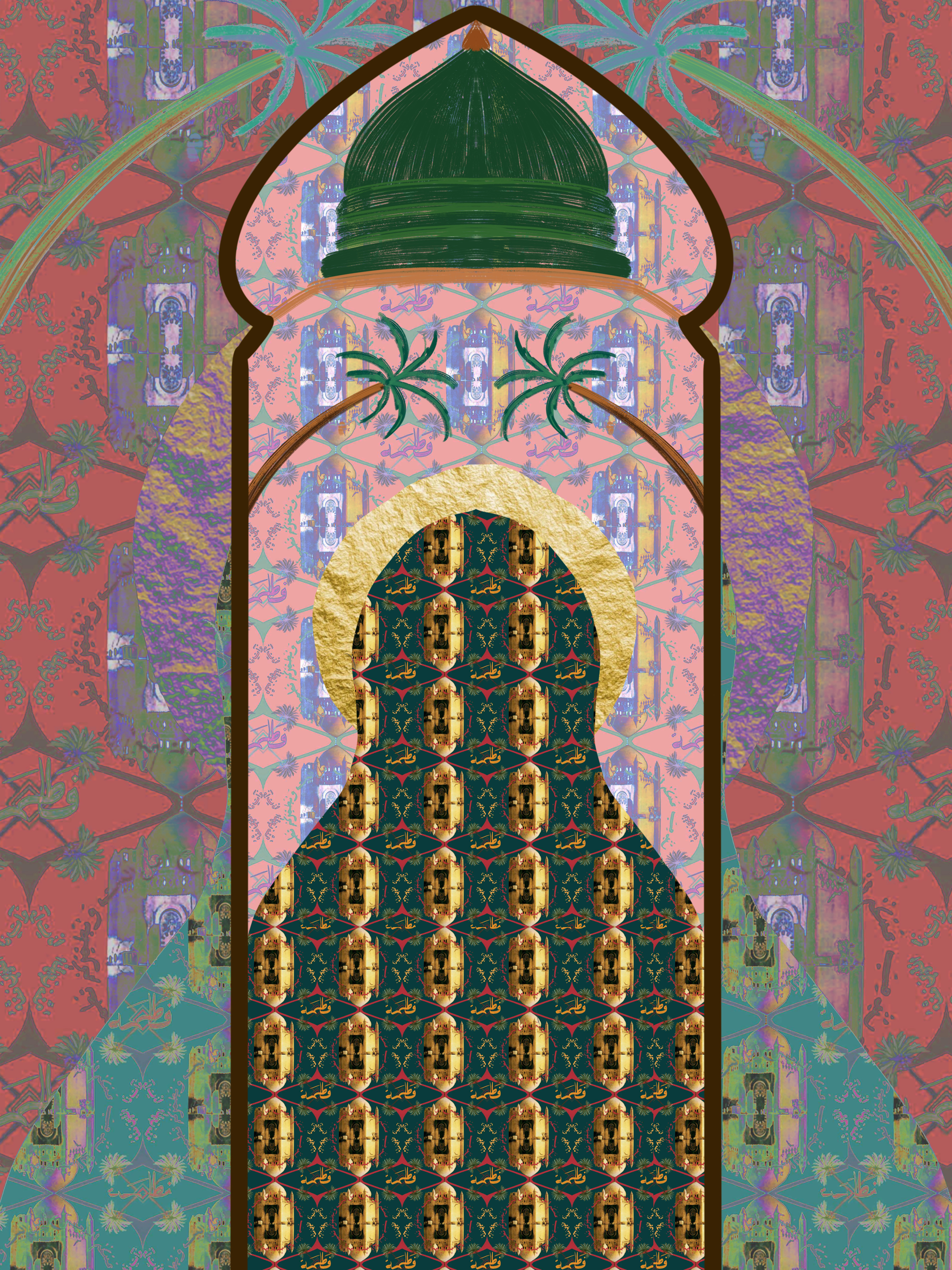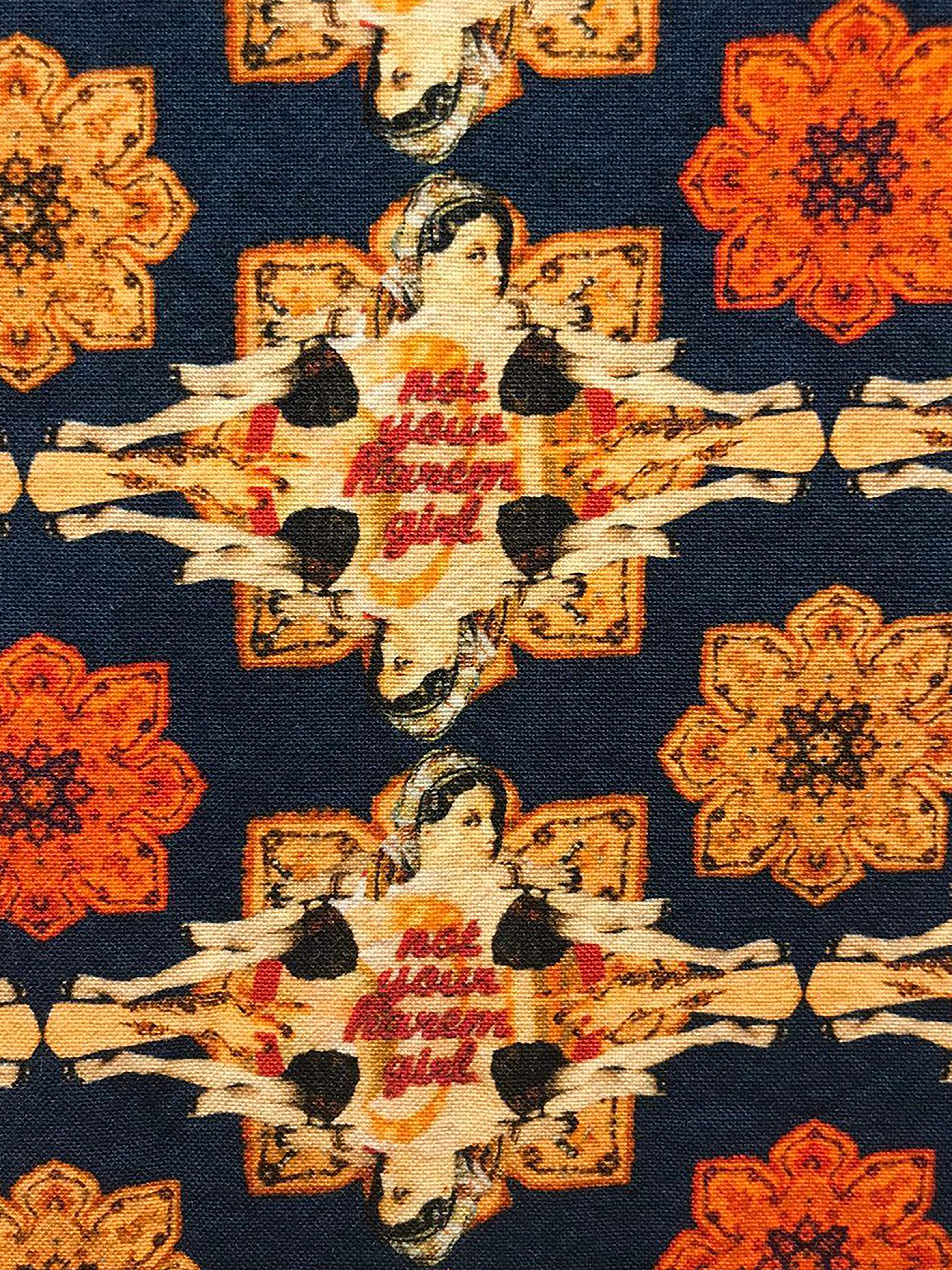Farwa Moledina
Interview by Linzi Stauvers
-
Published in September 2022
-
Farwa Moledina’s work is often a study of female Muslim identity. She is interested in how the western historical art narrative portrays the Muslim woman, and whether this has impacted ways in which Muslim women are viewed in the contemporary world. Moledina spoke with Linzi Stauvers, Head of Learning at Ikon Gallery, Birmingham, ahead of the launch of Moledina’s solo exhibition titled Women of Paradise at Ikon Gallery.
-
Your installation at Ikon Gallery is a study of the four women promised paradise in Islamic tradition. Who are these women and how have you depicted them?
The four women are:
- Aasiyah (a.s.) (adoptive mother of Musa (a.s.) (Moses))
- Maryam (a.s.) (mother of Isa (a.s.) (Jesus))
- Khadijah (a.s.) (wife of the Prophet Muhammad (s.a.w))
- Fatimah (a.s.) (daughter of Khadijah (a.s.) and Prophet Muhammad (s.a.w.))
The depiction of the faces of religious figures is not particularly encouraged in Islam, although some sects are more flexible than others. Out of respect for these women and for all Muslims, regardless of their stance, I chose to depict the four women in silhouette form. The silhouettes take the shape of women wearing a burqa or chador, with Maryam (a.s.) taking inspiration from the typical composition of Mary and Jesus found within Christian religious paintings.
The silhouettes are cut out of patterns I created that are specifically designed for each of the women and allude to their individual identities. For instance, the pattern created for Aasiyah (a.s.) is made from drawings of rivers, pyramids, Moses baskets and verses from the Quran dedicated to her. Each element hints at the identity of the woman, with the full pattern weaving a chronicle which is visible for those who wish to perceive the depth of the work beyond the visual surface (as inspired by the Islamic design principles which I’ve elaborated on below)

No One is Neutral Here, digitally printed textile, 300 x 140 cm (approx), 2019. Exhibited at the Lahore Biennale: A Rich Tapestry, installation view.
Your work is inspired by Islamic architecture. How have you used these design principles in composing Women of Paradise?
The structure of this piece particularly draws inspiration from the mihrab, which is a niche in the wall of a mosque that indicates the qibla (direction of Mecca). Muslims face the qibla when praying. The mihrab is normally ornately decorated and forms the architectural and spiritual focal point of a masjid’s (mosque) interior.
Masjid’s are often decorated in blues, greys and turquoise, and so the structural frames have been painted in grey with a border of turquoise. The border is formed of a pattern made from the Rub-el-Hizb (Islamic eight-pointed star, made from two squares overlapping)
The patterns printed on the textiles are also inspired by Islamic design principles, such as those of symmetry, recurrence and abstraction. Islamic geometric art is fundamentally based on the concept of Al-Tawhid (Divine Unity) (Burckhardt) and this is expressed through geometric symmetrical patterns that appear to be infinite. It encourages reflection of the self and the universe and the exploration of what lies beneath the visual surface. Designs intricately attempt to trace the origins in creation, encouraging viewers to reflect upon them not backwards but inwards (Critchlow, 1976). This concept informs the patterns of this piece, which are composed of a symmetrical geometric repeat pattern. The work requires contemplation to reveal its true meaning and depth. As the viewer identifies the different layers within the pattern, the unfolding personal history of each woman depicted in the work will provoke an inward examination of their own preconceived notions of Muslim women and Islamic tradition.

Women of Paradise – Fatimah (a.s.), digital illustration, 2021. Image courtesy of the artist.
Through your practice, you question the neutrality of contemporary galleries and museum collections. To what extent does Women of Paradise challenge dominant art historical narratives?
My practice generally, by default of existing as Muslim woman, challenges dominant art historical narratives and the neutrality of museums and galleries. Within my practice and belief, Mary has always been Maryam (a.s.), and this perspective puts into question the default narrative found within such spaces. When presented in a museum or gallery context, my viewpoint is naturally considered to be the other. Women of Paradise interrogates the assumption of neutrality within museums and galleries by providing a different perception of Mary who is a subject of equal cultural significance in the Middle East, whilst also presenting three other celebrated female figures largely unfamiliar to the western world.
Whilst there has been progress made in the presentation of Islamic art in museum and gallery collections in recent years, there is still a bias towards a Christian imagination within intuitions. Christian religious paintings are numerous and displayed within the main galleries, however Islamic viewpoints are always shown in a specific space dedicated to Islamic art where oftentimes different artefacts from different eras and sects are grouped together, without adequate contextualisation - Islam is a nuanced religion with different branches that are erased from the knowledge provided by these institutions. The Islamic artefacts found within museums are likely part of private and public collections, and so would have been influenced by Orientalism and the taste for the exotic, however this knowledge is also not presented.
The focus on the four Women of Paradise is in stark contrast to how Muslim and Middle Eastern women are usually presented in Museum and Gallery collections as, for the most part, they are depicted mostly within Orientalist paintings and are shown to be idle, vacant beings whose existence serves solely to add further ornamentation to an already exotic backdrop. There is a particular erasure of the personhood of Muslim women and their achievements in historical artworks and also contemporary society, which I attempt to explore through my work.

Women of Paradise – Aasiyah (a.s.), digital illustration, 2021. Image courtesy of the artist.
Your work often features textiles and embroidery. Is it a celebration of women’s labour and craft?
I come from a family of creative and inspiring women. Growing up surrounded by 6 of my 11 maternal aunties, I was taught different textile arts from them, including crochet, knitting, embroidery and bead work. My late aunt who passed away in April and who this work is dedicated to, was fond of cross stitch, but unfortunately this was one technique I could never quite get into. This is one of the reasons textile is so important to me, the thoughtfulness and care of the women in my family who taught me these artforms are woven into every stitch I make.
Textile is a hugely important aspect of my work also as textile has often been considered a craft associated with the domestic but has, in recent times, been reclaimed by female-identifying artists, re-establishing textiles as a contemporary artform within a patriarchal narrative. My use of textile allows me to explore personal and political histories whilst also paying homage to a skill often dismissed as womens’ work (and thus devalued). It absolutely is a celebration of women’s labour and a craft.

Not Your Harem Girl, (detail), digitally printed textile, 300 x 150 cm (approx), 2018. Image courtesy of the artist
How would you like Women of Paradise to be considered by gallery visitors?
Through this work, I hope that Muslims are able to view themselves and their histories represented in a gallery setting. I wish to encourage more critical thinking around museum and gallery displays. We are all products of our environments and the inbuilt biases that come with that, so I would like this piece to motivate viewers to reflect on their own prior notions of Islam, Muslim women, and what narratives they consider default (and why.)

Women of Paradise – Khadijah (a.s.), digital illustration, 2021. Image courtesy of the artist.
-
Women of Paradise runs between 09 September - 13 November 2022 at Ikon Gallery, Birmingham. More information can be found here.
-
︎ @farwamoledina
farwamoledina.com
-
If you like this why not read our interview with Yael Roberts.
-
© YAC | Young Artists in Conversation ALL RIGHTS RESERVED
